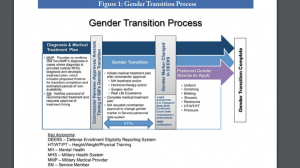Society values categories and labels such as sex and gender. These labels are meant to simplify the context of individuals; however, there are a mass number of individuals who do not fit into the societal categorical label. Sex is the biological genitalia of female or male set by societal norms. Gender is the social role associated with the sex of an individual. Gender identity is important to take into consideration because it is what people will self-identify as. Those who have a hard time fitting into a category they do not feel identifies with them go through gender dysphoria. Gender dysphoria is a medical diagnosis and can refer to severe distress for many transgender individuals.
History was made on the 30th of June in 2016 when the Department of Defense announced those who identified as transgender members may now go through a transgender transition within the military. This is a new milestone for the United States as a whole and will affect the lives serving and the lives supporting of those serving in order to function as a strong country. In addition to this particular policy, let it be known by the 1st of July in 2017, the military service will now accept transgender applicants if the general standard requirements are met. Former Secretary of defense, Ash Carter, requested the Department of Defense to assess the impact of issues related to transgender military personnel serving and the possible plans for addressing these issues.
Policy Guidance
With the announcement on Jun 30th, 2016, it was expected for the policy to change the entire military force: Army, Navy, Air Force, Marine Corps, and Coast Guard. The purpose of this decision supports the mission to defend the United States at all times. This means there needed to be an elimination of all barriers preventing those who are capably qualified to protect the United States and fulfilling the overall tasks of mission accomplishment and troop welfare. This policy establishes the recognition of transgender service members serving our military in present times. Those who choose to serve should be able to meet the general requirements in order to have the chance to serve alongside other military personnel. Those who are not familiar with the new policy are expected to go through a deliberate brief explaining the new implementations within each service. There is also a DoD Transgender Implantation Handbook easily accessible on the web that outlines the transition for service members and for those who command the service members.
Policy Approaches
Gender Transition Process (Figure 1) is the process in which the individual who wishes to undergo the transition process from male to female or from female to male. The plan is to initiate the diagnosis by some certified medical personnel once the chain of command of the individual is informed. The medical treatment and planning of the individual is accordingly with the unit’s timeline and there are no detrimental tasks coming up for both the individual and the unit. The next approaches of the gender transition will take place and there will be the execution of the medical treatment and recovery process. The final steps will be when the individual requests a service member gender marker change, and the chain of command follows through with the request. Once the gender marker is changed, the service member is expected to meet the general standards are the completed gender marker. This transition can only take place for once for an individual.
Implications
The Department of Defense is approaching a new culture when they decided to open the military service to all civilians. The point is to acknowledge those who can complete the mission to protect and defend the United States of America. Through the implementation of transgender individuals into the armed forces, the culture of the military might go through a backlash. This assumption is supported by the history of women in the military and the Department of Defense’s approval of women in combat roles announced on the 3rd of December in 2016. However, the message is clearly stated by the Department of Defense. If you can perform, the military needs you.
